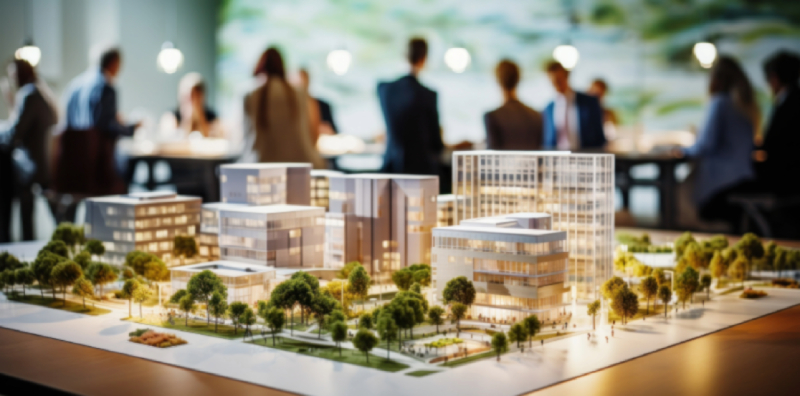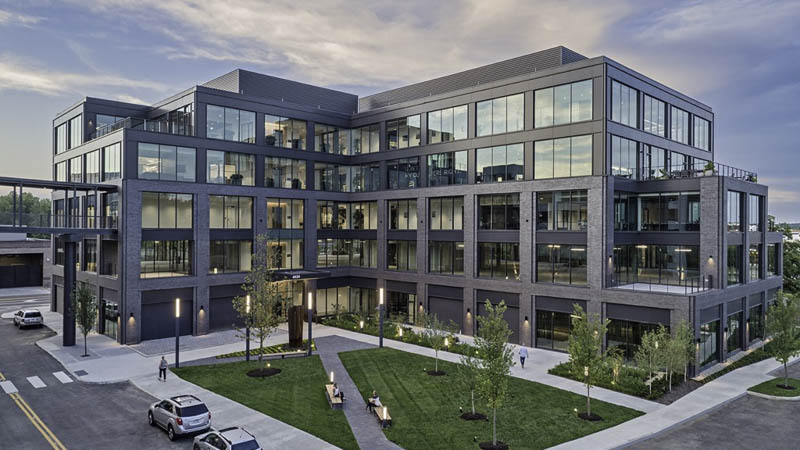Introducing the Comprehensive Providers Offered by Commercial Architects for Modern Dope
Commercial Architects offer a critical feature in contemporary advancement tasks. They mix style aesthetic appeals with performance while sticking to governing demands. Their expertise expands beyond plain construction, integrating sustainable practices and ingenious innovations. As they navigate complicated zoning regulations, Architects work together with different stakeholders to bring visions to life. This diverse method questions concerning the advancing role of Architects fit modern rooms and the impact of their work with future advancements.
Recognizing the Duty of Commercial Architects in Modern Developments
In contemporary metropolitan landscapes, Commercial Architects play an essential function in shaping useful and aesthetic areas that satisfy varied organization requirements. Their proficiency prolongs past simple design; they browse complicated zoning legislations, building codes, and ecological guidelines. By working together with customers, they determine particular demands, making sure that each task straightens with the client's vision while additionally considering useful elements such as sustainability and cost-effectiveness. Commercial Architects are skilled at integrating ingenious innovations and products right into their styles, improving both the functionality and energy efficiency of buildings. They perform complete site evaluations to analyze the prospective difficulties and chances offered by a place. Furthermore, efficient communication with professionals and other stakeholders is vital, making certain that the job proceeds smoothly from conception to completion. Inevitably, Commercial Architects are instrumental in creating areas that not just satisfy useful functions however also add to the total character and vibrancy of metropolitan atmospheres.
Principle Design: Changing Ideas Into Fact
Principle style works as a vital phase in Commercial design, where innovative layout solutions emerge from creative brainstorming. This procedure relies upon collective ideation, combining diverse point of views to fine-tune and enhance initial ideas. As ideas take shape, they transform from abstract notions right into concrete architectural truths.
Ingenious Style Solutions
Changing ideas into truth is the hallmark of cutting-edge style solutions in Commercial design. These solutions blend creative thinking with capability, resolving the distinct demands of modern growths. By leveraging sophisticated technologies and sustainable methods, Architects craft rooms that are not only visually appealing however likewise efficient and adaptable. Focus on customer experience drives the style procedure, guaranteeing that atmospheres foster efficiency and cooperation. Each task gain from a customized approach, where principles are meticulously created to show the client's vision while taking into consideration future fads. Innovative style services likewise prioritize versatility, permitting for alterations with time as company demands progress. Inevitably, these methods enhance the total worth of Commercial areas, making them essential in today's affordable landscape.

Joint Ideation Process
Cooperation functions as the backbone of the ideation process in Commercial design, fostering creative thinking and development among diverse stakeholders. Architects, customers, engineers, and neighborhood members take part in vibrant discussions, making sure that all viewpoints are considered. This comprehensive approach permits the expedition of different design principles, motivating one-of-a-kind services that align with the task's vision. With workshops and conceptualizing sessions, ideas advance and improve, changing preliminary concepts right into substantial designs. Modern technology also plays a critical duty, with tools such as Building Details Modeling (BIM) assisting in real-time collaboration and modifications. Inevitably, this joint ideation process not just boosts the layout end result however additionally cultivates a sense of possession and financial investment among all celebrations involved, leading to successful Commercial developments.
Zoning Evaluation: Navigating Rules and Compliance
As designers start on new jobs, comprehending zoning regulations is essential to making sure compliance and avoiding expensive delays. Zoning analysis plays an important function in this procedure, as it involves assessing local zoning legislations that dictate land usage, building height, thickness, and problems. Commercial Architects have the knowledge to navigate these complicated policies, helping customers recognize acceptable uses and any type of necessary differences.
Lasting Layout Practices: Structure for the Future
Lasting design practices are progressively important in the domain name of Commercial architecture, especially as ecological issues remain to escalate. Architects prioritize environment-friendly products, energy-efficient systems, and layout methods that reduce waste and ecological effect. Including renewable resource sources, such as photovoltaic panels and wind generators, allows structures to create their very own power and reduce dependence on fossil fuels.Furthermore, sustainable layout highlights the significance of indoor environmental quality. This consists of utilizing all-natural light, improving air flow, and selecting safe products to improve resident health and efficiency. Environment-friendly roofings and living wall surfaces are also popular functions that add to biodiversity and urban cooling.Additionally, Commercial Architects frequently incorporate water conservation strategies, like rain harvesting and drought-resistant landscaping. Via these cutting-edge methods, they produce spaces that not only satisfy modern demands but likewise cultivate a sustainable future, dealing with the expanding demand for liable growth in the modern globe.
Job Management: Ensuring Timely and Reliable Execution
Efficient task administration is essential for ensuring that Commercial design projects are finished promptly and within budget. This role encompasses a variety of responsibilities, consisting of the coordination of various stakeholders, timelines, and find more information resources. Commercial Architects take advantage of their expertise to create in-depth job plans that outline essential landmarks and deliverables, enabling organized progression tracking.Regular communication amongst staff member and customers is vital, cultivating transparency and promoting prompt decision-making. Danger management techniques are likewise utilized to determine possible challenges early, enabling aggressive remedies to be created. By using innovative job management devices, Architects can monitor project efficiency in real-time, making modifications as necessary to preserve effectiveness.
Inside Design: Creating Useful and Visual Spaces
Interior decoration plays a vital role in boosting both performance and aesthetic appeal within Commercial spaces. Reliable area preparation can optimize process and boost user experience, while visual layout concepts add to an aesthetically appealing environment - commercial architects. Together, these aspects create spaces that are not just functional however also inspiring
Space Planning Performance
While optimizing the utility of available space, Commercial Architects focus on space planning efficiency to create both useful and visually pleasing environments. This technique involves cautious evaluation of the spatial layout to ensure perfect use every square foot. Architects take into consideration factors such Discover More Here as workflow, access, and all-natural light to enhance use. By purposefully putting furniture, tools, and workstations, they promote motion and communication among individuals, advertising productivity. Furthermore, zoning various areas for particular features helps in managing sound and privacy, developing an unified ambience. With reliable space preparation, Commercial Architects can transform constraints into possibilities, making sure that each area fulfills the diverse needs of its passengers while adhering to regulative needs and market requirements.
Visual Style Concepts
Aesthetic layout principles play a vital role in shaping atmospheres that are not only functional yet also aesthetically enticing. These concepts lead Commercial Architects in producing areas that reverberate with users while improving brand name identity. Crucial element consist of balance, percentage, and consistency, which collaborate to produce a natural appearance. Color pattern and products are very carefully picked to stimulate wanted emotions and sustain the general theme. In addition, illumination plays an essential role, influencing mood and visibility while highlighting architectural attributes. By incorporating these principles, Architects ensure that spaces are not just useful but likewise inviting and motivating. Eventually, effective aesthetic design fosters a favorable individual experience, encouraging engagement and complete satisfaction in Commercial settings.
Partnership With Stakeholders: Fostering Successful Partnerships
Effective partnerships in Commercial style rest on effective partnership with stakeholders, guaranteeing that every voice is listened to and valued. This collective approach includes interesting numerous parties, consisting of customers, professionals, and community members, throughout the design and growth procedure. By fostering open communication, Commercial Architects can deal with problems, gather understandings, and straighten the project's vision with stakeholder expectations.The assimilation of varied point of views improves imagination and development, leading to even more practical and visually pleasing styles. Normal meetings, responses sessions, and workshops facilitate this discussion, enabling Architects to adapt their strategies in response to stakeholder input. Additionally, establishing depend on through openness and liability reinforces these partnerships, resulting in a smoother task execution.Ultimately, the success of contemporary developments depends upon the Architects' capacity to browse and harmonize differing passions, creating a collaborative environment that advertises common objectives and common success.
Regularly Asked Questions
How Do Commercial Architects Deal With Budget Plan Constraints During a Task?

What Types of Software Application Do Commercial Architects Typically Make Use Of?
Commercial Architects typically use software application such as AutoCAD for composing, Revit for Structure Details Modeling, SketchUp for 3D modeling, and project administration tools like Microsoft Project to improve partnership commercial architects and simplify workflows throughout the layout process.
Can Commercial Architects Help With Obtaining Funding for Projects?
Commercial Architects can assist in getting funding for tasks by preparing detailed propositions, aiding to verbalize style visions, and giving economic projections that can boost the chance of protecting essential financing from capitalists or banks.
How Do Architects Make Certain Security During the Construction Refine?
Architects ensure security throughout building and construction by applying strenuous design criteria, collaborating with engineers, conducting normal site inspections, adhering to neighborhood laws, and promoting communication amongst all stakeholders to minimize risks and promote a protected workplace.
What Continuous Assistance Do Architects Supply After Project Completion?
After job completion, Architects use recurring support through maintenance consultations, performance analyses, and layout adjustments. They guarantee structures satisfy developing requirements, address prospective problems, and keep compliance with policies, cultivating a long-lasting connection with clients.